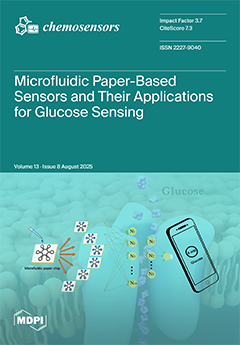A novel near-infrared (NIR) squaraine-based chemosensor,
SQ-68, has been designed and synthesized for the sensitive and selective detection of Cu
2+ and Ag
+ ions, offering a compact solution for multi-analyte sensing.
SQ-68 demonstrates high selectivity, with its performance influenced by the
[...] Read more.
A novel near-infrared (NIR) squaraine-based chemosensor,
SQ-68, has been designed and synthesized for the sensitive and selective detection of Cu
2+ and Ag
+ ions, offering a compact solution for multi-analyte sensing.
SQ-68 demonstrates high selectivity, with its performance influenced by the solvent environment: It selectively detects Cu
2+ in acetonitrile and Ag
+ in an ethanol–water mixture. Upon binding with either ion,
SQ-68 undergoes significant absorption changes in the NIR region, accompanied by visible color changes, enabling naked-eye detection. Spectroscopic studies confirm a 1:1 binding stoichiometry with both Cu
2+ and Ag
+, accompanied by hypochromism. The detection limits are 0.09 μM for Cu
2+ and 0.38 μM for Ag
+, supporting highly sensitive quantification. The sensor’s practical applicability was validated in real water samples (sea, lake, and tap water), with recovery rates ranging from 73–95% for Cu
2+ to 59–99% for Ag
+. These results establish
SQ-68 as a reliable and efficient chemosensor for environmental monitoring and water quality assessment. Its dual-analyte capability, solvent-tunable selectivity, and visual detection features make it a promising tool for rapid and accurate detection of heavy metal ions in diverse aqueous environments.
Full article





